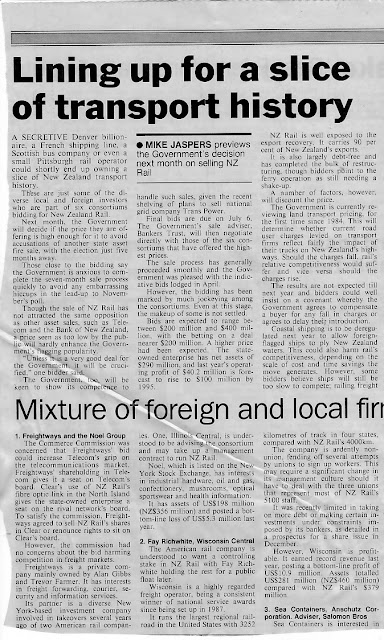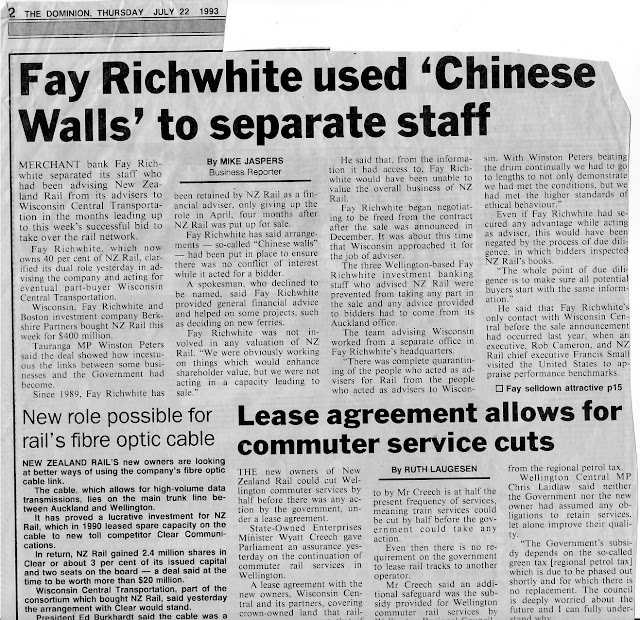Following on from the preparation for privatisation, this is a series of articles approaching and following the privatisation of NZ Rail Ltd.
In the first article (2 parts) John Goulter writes a brief history of how rail was restructured in the 1980s from a lumbering government department with a statutory monopoly on long haul freight to a competitive, lean and business oriented state owned enterprise ten years later. General Manager of NZ Rail Ltd Francis Small notes the public doesn't see much of the company, as 70% of its revenue was freight. He notes that in 1984 Booz Allen Hamilton describe the NZRC as the "worst performing railway in the OECD", yet now it makes a profit from passenger services (excluding commuter services which are contracted for) and is still NZ's largest hauler of freight.
Graphs in the article depict a drop in the number of wagons from around 28,000 in 1981 to 9,400 in 1992, largely reflecting scrapping a lot of small, four-wheeled wagons which had poor payload to net weight, and slow operating speeds. Another graph depicts staff numbers dropping from around 21,000 to around 6,000 in the same time period.
A pressing issue for privatisation is the capital needed for renewals. At the time, the three Interislander ferries were between 10 and 21 years old, with the Arahanga and Aratika needing replacement by the end of the 1990s. Locomotives and EMUs had an average age of 20 years, along with many freight wagons, noting also the long-distance passenger rail stock dated from the late 1930s-mid 1940s (except for the Silverfern railcars). The Government of the day was keen to avoid needing to inject capital to replace old ferries, locomotives and wagons.
Notable was former Railway Minister Richard Prebble expressing concern of the risk of privatisation that rail would be run into the ground, and there were no guarantees that certain services would be kept in place.
The second articles (3 parts) lists the six consortiums that were bidders for the purchase of NZ Rail Ltd. Bids were expected between $200m-$400m, with net assets valued at $290m. These were:
- Freightways and the Noel Group: Freightways was known as a major freight operator, but Noel Group was a US based investment company with investments in railways in the US
- Fay Richwhite and Wisconsin Central (the eventual winner) Fay Richwhite was investing to enable a public float, but Wisconsin Central is a major regional railroad in the US with a network at the time nearly the same length as NZ Rail.
- Sea Containers, Anschutz Corporation: Sea Containers was particularly interested in the ferry business, but also rail. Anschutz owned Southern Pacific and the Denver & Rio Grande in the US (both later acquired by Union Pacific).
- Mainfreight/Brierleys/Railroad Development Corporation: Mainfreight is a major NZ Rail customer, but Brierleys was seen as having interest as it was a part shareholder of the Union Shipping Group. RDC was a minor owner of railroads in the US and Argentina.
- Port of Tauranga and Port of Lyttelton, Pacifica Shipping, National Mutual and AMP: At the time Port of Tauranga took 25% of rail freight, and Lyttelton was important for coal traffic. Pacifica saw the acquisition complementing its coastal shipping operation, and the insurance/investment firms were there for the later stock float.
- Ports of Auckland and Wellington, Sofrana-Unilines and Stagecoach: Mirroring Port of Tauranga for competition, Auckland saw the investment as strategic. Wellington saw NZ Rail as its biggest customer with the Interislander. Stagecoach was seen as wanting to complement its bus business in Wellington. Sofrana was a French shipping line.
The third article is the Evening Post editorial after the privatisation had been concluded, on 21 July 1993. It hoped that NZers would still be able to travel by rail following privatisation, given the assurances the new owners had given. Noting NZers had had plenty of exposure to privatisation over the past five years and it appeared to be getting easier, plus those that wished could buy shares themselves. The sale price was $328m, which was seen as relatively high. It noted NZers should be relieved that a specialist transport company has bought it, and that although it would cost billions to replace it, there was a lot of capital spending needed for it to remain competitive.
The fourth article is by Mike Booker in the Dominion, summarising the history of NZ Railways, noting the Vogel era and the opening of the South Island Main Trunk in 1878, the North Island Main Trunk in 1908 and the West Coast connected to the rest of the network in 1923, and Whangarei connected to Auckland before WW2. The peak of the network length was 1953. It noted NZ Rail Ltd had 5,100 staff compared to 25,000 in 1953. It noted NZR has owned ships since 1902 (as the original owner of the Earnslaw, followed by Cook Strait Ferries) and buses from 1926 until sold in 1991. The Railways Department was profitable for most of its existence, until the 1960s as minor branch lines became an increasing burden and competition from road freight had grown (even though much of it was limited to 40 miles distance until 1978). The first talk of privatisation was in June 1989 under the then Palmer-led Labour Government, but it was carried out by the Bolger National Government. A brief chronology was included.
A related article next to it describes how Wisconsin Central was bullish about growth of traffic for NZ Rail Ltd, given it had generated 10% per annum growth in the US. This enthusiasm also applied to passenger traffic. NZ Rail Ltd was Wisconsin Central's first investment outside the US. It noted that Wisconsin Central carried 2.5x as much freight per km as NZ Rail.
The fifth article by Brent Edwards in the Evening Post describes how Wisconsin Central is in the NZ Rail investment for the "long haul". It noted that the Wisconsin Central consortium would pay around $400m for the business. Wisconsin Central President Ed Burkhardt believed that the focus now was on growth, as the staff cuts had largely been completed. Then Finance Minister Ruth Richardson said the bid was at the upper end of expectations and was the "best" and "cleanest" bid. Winston Peters, who had only just launched NZ First, called privatisation "economic treachery", but Opposition Leader Mike Moore was critical but stopped short of saying a Labour Government would buy it back. Wisconsin Central was destined to take 60% of NZ Rail, with Fay Richwhite 40% in order to float that shareholding on the stockmarket.
The sixth scan is a series of articles as follows:
- Fay Richwhite used "Chinese walls" to separate staff that had been advising NZ Rail on the privatisation process, and being part of the bid with Wisconsin Central
- NZ Rail's new owners say it would continue to lease out its fibre-optic cable network to Clear Communications seeing it as a "valuable asset"
- The new owners of NZ Rail could cut commuter services by half before Government could require it to let another operator provide the service using its tracks.
- Finance Minister Ruth Richardson saying the Government got the best deal with the sale to Wisconsin Central. It noted the Government would clear $72m in debt of NZ Rail from the sale, with the remainder $328m available for the Crown. It noted that NZRC would continue to own the land under the track and stations.
 |
| NZ Rail ready for sale - Evening Post 1/03/93 |
 |
| Bidders for NZ Rail - Dominion 23/06/93 |
 |
| Evening Post Editorial - 21/07/93 |
 |
| 21 July 1993 - Evening Post |
 |
| Dominion 22 July 1993 |








No comments:
Post a Comment
Comments are gratefully received, but comments containing abuse or spam will be deleted